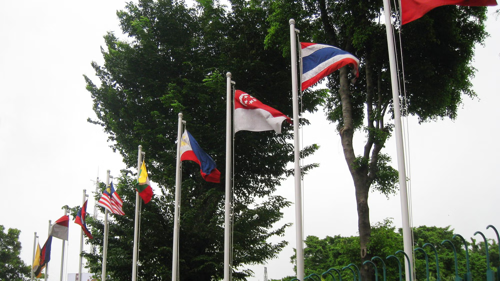The Distillery #16: AWS & Microsoft Outages Raise Cloud Questions, as World Bank Eyes ASEAN Digital ID

First AWS, now Microsoft.
Last week, a DNS failure caused a major AWS outage in the US; triggering a cascade that took down services including Disney+, Fortnite, and Zoom. And yesterday, Microsoft’s Azure platform ran into the same problem; disrupting everything from Minecraft to London Heathrow Airport.
Here's some food for thought: Are enterprises overestimating cloud reliability? And is time to take mutli-cloud strategies seriously?
Also in this edition:
- The World Bank sets its sights on ASEAN; launching a major assessment of cross-border digital identity readiness.
- We’ve rolled out the Juniper Research Competitor Directory — here's how you can see your company’s place in the global tech landscape.
- The travel eSIM market just had a record year — but what’s this driving this growth?
- Our latest insights on business messaging, private networks, fraud prevention, quantum computing, and smart buildings.
FINTECH & PAYMENTS
World Bank Targets ASEAN for Cross-border Digital Identity Push

The World Bank has issued a call for proposals to assess how ready the Association of Southeast Asian Nations (ASEAN) is for cross-border digital identity systems — a move that could mark a major step toward regional interoperability.
The project aims to create a shared framework for digital identities across Southeast Asia; evaluating the region’s technical standards, trust frameworks, and existing capabilities.
Distilled…
🟣 ASEAN is well placed to test interoperable digital identity schemes. Several member states — including Brunei, Indonesia, Malaysia, Singapore, and Thailand — already run national programmes, and the ASEAN Digital Masterplan 2025 signals a strong commitment to becoming a fully digital economy and society.
🟣 Cross-border mobility, digital services, and payments already drive much of ASEAN’s economy, so digital authentication is already second nature for many citizens. Our latest figures show the region’s digital identity app base jumping 407% over the next five years; from 166 million in 2025 to 842 million by 2030. Interoperability could push that even further.
🟣 Success will hinge on coordination. Unlike the EU’s supranational model, ASEAN’s consensus-driven structure makes cooperation critical. Any regional framework — comparable to Europe’s eIDAS and EUDI initiatives — must reflect ASEAN’s infrastructural diversity and political realities. Still, its youthful population and mobile-first economies could make it one of the most promising regions for cross-border digital identity adoption.
ANNOUNCEMENT
Introducing the Juniper Research Competitor Directory!

We’ve just rolled out our new Competitor Directory — a searchable database of 900+ technology vendors across the fintech, telecoms and IoT ecosystems. It’s the first time you can see every company featured in our reports, awards and leaderboards in one place; offering a clearer picture of the global technology landscape.
We have plans to add more features and expand the existing content, but in the meantime, we’re inviting you to take a look through the directory to see how your organisation appears — and where you stand among your peers. If you’re not yet listed, or something needs updating, get in touch with our team to make sure your profile reflects your position in the market.
TELECOMS & CONNECTIVITY
Travel eSIM Just Had a Record Year — Here’s What Comes Next

The summer holiday season might be over, but the travel eSIM market hasn’t cooled off. With more travellers keeping their phones connected abroad, revenue is set to jump 85% this year to $1.8 billion — up from $989 million in 2024.
To mark the launch of our new travel eSIM research, we’ve pulled out three insights, exclusively for readers of The Distillery, on where the market is heading — and what providers can do to ensure they don’t hit turbulence any time soon.
🟣 Mobile operators are steadily carving out a greater share of the market. Third-party providers still dominate — accounting for 92% of travel eSIM revenue today — but operators are striking back; launching their own services and integrating them into mobile plans and loyalty programmes to re-engage 'silent roamers' and reclaim revenue that once flowed elsewhere. By 2030, their share is set to reach 18%, or around $1.5 billion.
🟣 Partnerships are quickly becoming the backbone of the travel eSIM ecosystem. Our Partnerships Matrix shows that the providers making the biggest impact are those meeting travellers at the right moment — when they’re booking flights, checking in, or planning their stay. By working with airlines, online travel agencies, and hotel groups, they’re making connectivity part of the travel experience itself, rather than a post-arrival afterthought.
🟣 Growth markets such as Brazil, Mexico, South Africa and Thailand are emerging as key battlegrounds for travel eSIM adoption; fuelled by partnerships with airlines and neobanks bundling connectivity into their offerings. But expansion into these regions also brings greater regulatory scrutiny. Recent restrictions on travel eSIM providers in India and Turkey underscore the need to prioritise compliance, localisation, and data sovereignty as the market scales.
ICYMI
The Last Drop
We can’t fit all our work from the last fortnight in one issue, so here’s a hand-picked selection of blogs, infographics, and insights that deserve your attention.
💬 OTT business messaging traffic is set to surge 45% globally by 2028, as enterprises double down on channels such as WhatsApp to cut through the noise of traditional SMS.
🏆 Fresh from Thales’ latest Future Digital Award win, we caught up with SVP Guillaume Lafaix to talk about how private networks are evolving.
🤖 AI agents are taking centre stage; promising customer experiences that feel more human than ever. We’ve unpacked the key takeaways from Amazon Connect Horizons 2025 — and what they reveal about where CX is headed next.
🧠 Fraud detection and prevention spending will climb to $21 billion by 2029; driven by the growing sophistication of online scams.
⚛️ Quantum tech is having a moment. Big breakthroughs and even bigger investments are driving industry buzz — but how much is hype?
🏙️ Smart building interoperability frameworks will underpin $241 billion in spend by 2028, as property developers, utilities, and tech vendors align around common standards.
Latest research, whitepapers & press releases
-
 ReportDecember 2025
ReportDecember 2025AI Agents for Customer Experience Platforms Market: 2025-2030
Our comprehensive AI Agents for Customer Experience Platforms research suite comprises detailed assessment of a market that is set to disrupt mobile communications. It provides stakeholders with insight into the key opportunities within the AI agents for customer experience platforms market over the next two years.
VIEW -
 ReportDecember 2025Fintech & Payments
ReportDecember 2025Fintech & PaymentseCommerce Fraud Prevention Market: 2025-2030
Our eCommerce Fraud Prevention research suite provides a detailed and insightful analysis of this evolving market; enabling stakeholders from financial institutions, law enforcement agencies, regulatory bodies and technology vendors to understand future growth, key trends, and the competitive environment.
VIEW -
 ReportNovember 2025Telecoms & Connectivity
ReportNovember 2025Telecoms & ConnectivityeSIMs & iSIMs Market: 2025-2030
Juniper Research’s eSIMs and iSIMs research suite offers insightful analysis of a market set to experience significant growth in the next five years. The research suite provides mobile network operators (MNOs), original equipment manufacturers (OEMs), and eSIM management and platforms vendors with intelligence on how to capitalise on the market growth, and guidance on how eSIM-only devices and sensors, SGP.42, in-factory provisioning, and iSIMs will change the competitive landscape.
VIEW -
 ReportNovember 2025Fintech & Payments
ReportNovember 2025Fintech & PaymentsModern Card Issuing Platforms Market: 2025-2030
Our Modern Card Issuing Platforms Market research suite provides a detailed and insightful analysis of this evolving market; enabling stakeholders from banks, financial institutions, fintech companies, and technology vendors to understand future growth, key trends, and the competitive environment.
VIEW -
 ReportNovember 2025Fintech & Payments
ReportNovember 2025Fintech & PaymentsDigital Wallets Market: 2025-2030
Our digital wallets research suite provides detailed analysis of this rapidly changing market; allowing digital wallet providers to gain an understanding of key payment trends and challenges, potential growth opportunities, and the competitive environment.
VIEW -
 ReportOctober 2025Fintech & Payments
ReportOctober 2025Fintech & PaymentsDigital Identity Market: 2025-2030
Juniper Research’s Digital Identity research suite provides a comprehensive and insightful analysis of this market; enabling stakeholders, including digital identity platform providers, digital identity verification providers, government agencies, banks, and many others, to understand future growth, key trends, and the competitive environment.
VIEW
-
 WhitepaperDecember 2025Telecoms & Connectivity
WhitepaperDecember 2025Telecoms & ConnectivityHuman + AI: Drivers of Customer Experience AI Agents in 2026
Our complimentary whitepaper, Human + AI: Drivers of Customer Experience AI Agents in 2026, examines the key drivers of the AI agents for customer experience platforms market in 2025.
VIEW -
 WhitepaperDecember 2025Fintech & Payments
WhitepaperDecember 2025Fintech & PaymentsBeyond Chargebacks: The True Cost of Fraud for Digital Commerce
Our complimentary whitepaper, Beyond Chargebacks: The True Cost of Fraud for Digital Commerce, examines the state of the eCommerce fraud prevention market; considering the impact of evolving digital fraud strategies, including key trends such as identity theft, account takeovers, chargebacks, policy abuse and friendly fraud.
VIEW -
 WhitepaperNovember 2025Telecoms & Connectivity
WhitepaperNovember 2025Telecoms & ConnectivityeSIM-only Devices: The Impact on Operators, Consumers, and IoT
Our complimentary whitepaper, eSIM-only Devices: The Impact on Operators, Consumers, and IoT, explores the challenges and opportunities for the three segments, with a particular focus on eSIM-only smartphones and SGP.42.
VIEW -
 WhitepaperNovember 2025Fintech & Payments
WhitepaperNovember 2025Fintech & PaymentsUnlocking the Next Stage of Growth for Modern Card Issuing Platforms
This free whitepaper analyses key trends shaping the modern card issuing space, and the ways in which modern card issuing platforms can capture growth.
VIEW -
 WhitepaperNovember 2025Fintech & Payments
WhitepaperNovember 2025Fintech & PaymentsTop 10 Fintech & Payments Trends 2026
Fintech is evolving fast. From stablecoins to agentic AI, our annual guide reveals the shifts redefining payments, digital identity, and the future of money in 2026. Download your copy today.
VIEW -
 WhitepaperNovember 2025Fintech & Payments
WhitepaperNovember 2025Fintech & PaymentsDigital Wallets: Empowering Financial Inclusivity
Our complimentary whitepaper, Digital Wallets: Empowering Financial Inclusivity, examines the state of the digital wallets market; considering the impact of digital wallets on different geographies, how they are shaping the modern payments landscape through lower transaction fees and promoting financial inclusivity for underbanked populations, and how they are competing with established payment methods.
VIEW
-
Fintech & Payments
Digital Identity App Usage to Hit 6.2 Billion by 2030, Driven by Shift to Decentralised Models
December 2025 -
Telecoms & Connectivity
Travel eSIM Margins Under Pressure as Revenue per Gigabyte Falls 10% Globally in Two Years
December 2025 -
Telecoms & Connectivity
AI Agents to Power 1,000% More Customer Interactions for Enterprises Globally by 2027
December 2025 -
IoT & Emerging Technology
Global D2C Revenue Set for $370 Million Surge, But Satellite Operators Should Not Chase Full MNO Status
December 2025 -
Fintech & Payments
Digital Goods Fraud to Cost eCommerce Merchants $27 Billion Globally by 2030 as AI Tools Accelerate Attacks
December 2025 -
Fintech & Payments
AML Adoption to Hit 3.8 Million Businesses Globally by 2030, With Europe at the Forefront
November 2025



















